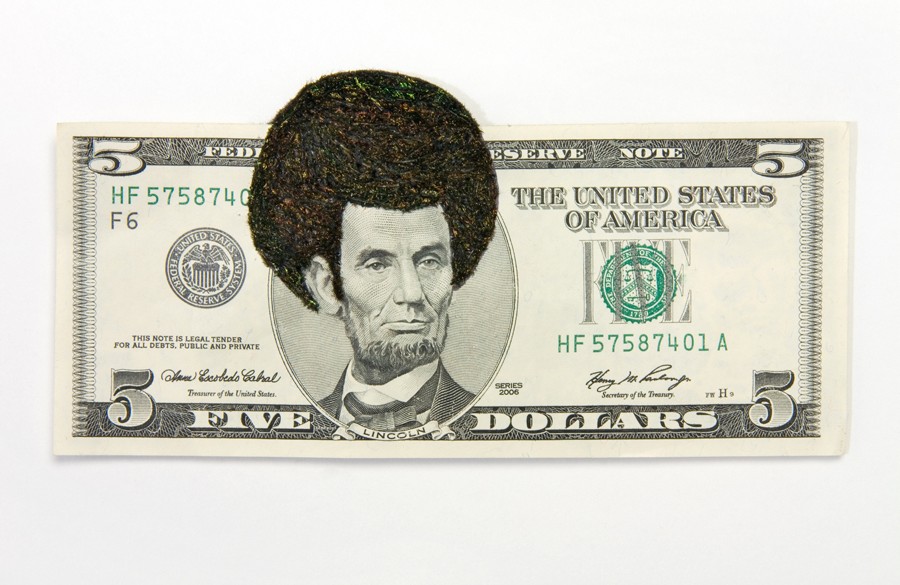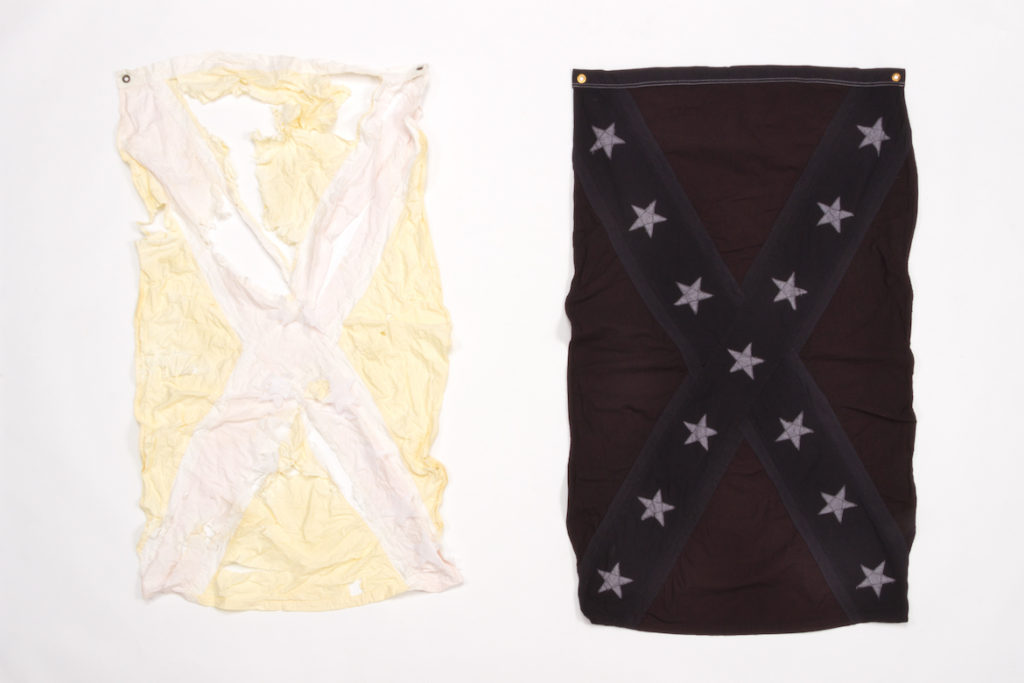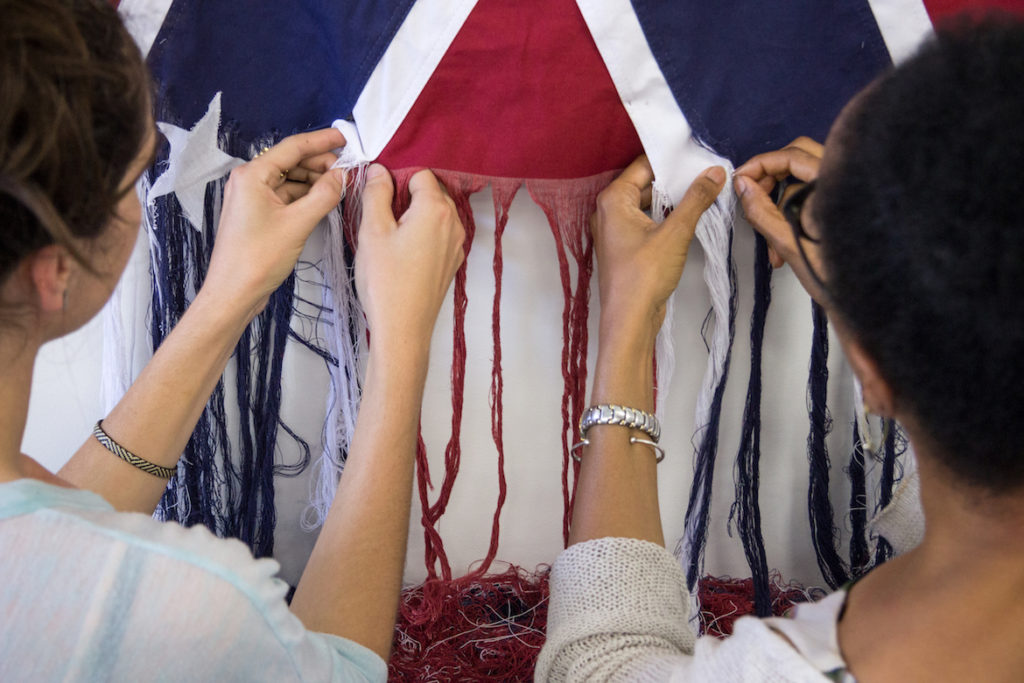“What would this [Confederate] flag look like if we took it down to its threads?” Sonya Clark wondered. She had made art about the Confederate (battle) flag before.
But the idea of literally unraveling the racist flag was on her mind with the arrival of the 150th anniversary of the end of the United States’ Civil War. Which also coincided in 2015 with an increased awareness of the systemic racism running through America that fuels murderous violence against African-Americans. “This was around the time it became front and center in the press,” Clark says. “Not that it was new, but it was news, the legacy of human beings who are of African descent whose bodies get treated as less than human. By this I mean police brutality and modern day lynching of black people.”
The spread of smartphones had enabled more brutality against African-Americans to be videotaped, to be documented—and everyone was then watching the evidence on their smartphones. “It was hard for people to bear, to look this history in the eye,” Clark says.
“We know that the way in which African-Americans are treated in this country is tied to the history of the enslavement of the people. The system is rigged,” Clark says. Schools for African-Americans are worse. Incarceration rates for African-Americans are higher. “And police are more brutal. And that’s all because of this deeply embedded notion that black and brown bodies are not as valuable.”
“I really started thinking about how long would it take until the Confederacy didn’t haunt us anymore,” says Clark, who will be presenting her participatory performance “Unraveling” the Confederate flag at Amherst College’s Mead Art Museum in Amherst, Massachusetts, at 5:30 p.m. Wednesday and again on April 5. Deconstructing the Confederate flag became a metaphor. “I just wanted to see what it would look like. If that piece of cloth was taken down to its threads would it become this passive thing? Would you think that maybe it came from the American flag?”
With help from studio assistants she unraveled a Confederate flag and turned it into piles of red, white and blue thread that sit side by side on a shelf. “I do think it’s more passive,” Clark says. “But it’s still filled with implications.”
She exhibited “Unraveled” in a group show at New York’s Mixed Greens gallery that summer. At the opening that June 11, she invited visitors to help her for the first time with a public performance of “Unraveling,” in which she’d unravel another Confederate flag live in the gallery.
“About 50 people lined up with me. I’m always the constant and one by one they joined me. I show them how to unravel and have a private conversation,” Clark says.
“In the piece, we are literally in a confessional stance,” Clark says. “Our gaze is not locked, but our hands are working together.”
Help Wonderland keep producing our great coverage of local arts, cultures and activism by contributing to Wonderland on Patreon. And sign up for our free, weekly newsletter so that you don’t miss any of our reporting.

Hair And Flags And Racism
Clark grew up in Washington, D.C., the daughter of a psychiatrist from Trinidad and a nurse from Jamaica. Her mom’s mom, a tailor, instilled in her an appreciation for craft, for the handmade. Clark studied psychology at Amherst College then art—particularly fiber and textiles—at the School of the Art Institute of Chicago and Cranbrook Academy of Art.
From 2006 to 2017, she was the chair for the Craft/ Material Studies Department at Virginia Commonwealth University in Richmond. “It was the first time I lived in the South and then found myself at the seat of the Confederacy,” she says. (She’s on sabbatical from the university while at Amherst as a visiting artist-in-residence.)

Her art explored the intersections of black hair, African-American achievement, textiles, handcraft and racism in America. With black combs, she made a portrait of Madam CJ Walker, the African-American woman said to be the first American female self-made millionaire from the success of her line of beauty and hair products for African-American women. Clark added an afro onto the portrait of Abraham Lincoln on a $5 bill. She invited hairdressers to “demonstrate their expertise” by making fabulous designs with her hair.
In spring 2010, “then-Governor Bob McDonnell, the governor of Virginia, he had proclaimed April ‘Confederate History Month,’” Clark recalls. “In his proclamation he made no mention that Richmond, like Rome, was built on the backs of slaves.”

So Clark began confronting the Confederate flag with “Black Hair Flag” (2010). She took a painted Confederate flag (so she wouldn’t have to buy one) and stitched in black thread in the pattern of the U.S. flag. Corn rows of black thread “to make reference to people working the land and also to the hair” formed the stripes. And Bantu knots in reference to the African people and the hairstyle became stars. Clark says, “To imply the body by putting hair in the space and to imply the story.”
For “Black and White Flag” (2015), she bleached one Confederate flag and dyed another black. “I tried to bleach it until it’s pure white and of course it won’t do that,” Clark says. “The bleach destroys the flag before it erases the imagery. Likewise when I dye it black … it doesn’t go completely black.” The stars and bars design of the flag still bleeds through.

At Amherst’s Mead Art Museum, Clark is also exhibiting her 2017 piece “Monumental Cloth.” While in residence at the Smithsonian museum in Washington, D.C., some years ago, she found the “Confederate flag of truce.” It’s a white linen dish towel yellowed with age, with three thin stripes and fringe along the end. At the end of the war, Confederate leaders waved it to Union lines as they sought a meeting to learn what terms of surrender the American military was offering. “It’s the piece of cloth that ended the Civil War,” Clark says.
The Smithsonian has half of the flag, Clark says, and the other half was divided into pieces that ended up in private collections and in museums across the South. Clark’s artwork is a “faithful reproduction” of all the pieces with black sutures down the middle binding the halves back together.

A Sickness Long With This Country
When Sonya Clark first invited visitors to join her in “Unraveling” at that New York gallery in 2015, “In two hours with 50 people, we unravel half an inch or an inch,” Clark says. “It’s about the process that we’re still going through. Just a few days after performing that, Dylann Roof murdered people in South Carolina because of the hate in his heart, an American bred hate.”
At Amherst’s Mead Art Museum on Wednesday, Clark will again invite visitors to join her in “Unraveling.” She spends two to three minutes with each person, showing them how to carefully disassemble the flag, and talking with the volunteers about what moved them to participate, “asking them what it means to them,” Clark says. “That’s been incredibly informative to me.”
A white mother with a black child who joined her on one occasion said, “I want to come up with him because we’ve been talking about what it means to be a black boy in America. For this mother to realize her son is vulnerable in a different way.”

But also some people have taunted her with notes saying that it’s not the Confederate flag but a Confederate battle flag—flown by some Confederate military units during the Civil War and incorporated into the 1863 and 1865 versions of the national flag of the Confederacy. “We know the Confederate battle flag really because it got popularized with the rise of the KKK,” Clark says.
Some have claimed to her that the flag is not a racist symbol, “the whole ‘heritage, not hate’ thing,” Clark says. “I’m a first generation American, so people question my right to know anything about America, to know anything about the South.”
With the election of Donald Trump, “America’s had a real wake-up call,” Clark says. “America thinks of itself as the place of wonderful, wonderful, wonderful equality, but it has never been. It’s an ideal. It’s something we’re working toward. But it’s never been achieved. … Trump is indicative of a sickness that has long been with this country.”
She’s performed “Unraveling” three times since Trump was elected. “I’ve had museums be concerned about my well being,” Clark says. And she’s had “people who are unraveling next to me telling me about their family members that are KKK members. I don’t think we would have been having these sorts of conversations without this divisive, xenophobic, sexist, racist—I don’t want to get into name calling—if we didn’t have this president.”
The flag she’ll invite people to help her unravel at Amherst is “a cotton, pieced Confederate battle flag,” Clark says. “It’s a hardy piece of cloth. It’s a hardy flag. So it’s difficult to undo.”
“A part of the cloth will be easy to pull out threads and when people get into that rhythm they don’t want to stop,” Clark says. “At times they’ll try to pull out a thread and it will break and it’s very unsatisfying.”
Clark sees all of it as a metaphor: “It’s collective work that needs to be done. And it’s undeniable that it needs to be done.”
Help Wonderland keep producing our great coverage of local arts, cultures and activism by contributing to Wonderland on Patreon. And sign up for our free, weekly newsletter so that you don’t miss any of our reporting.
